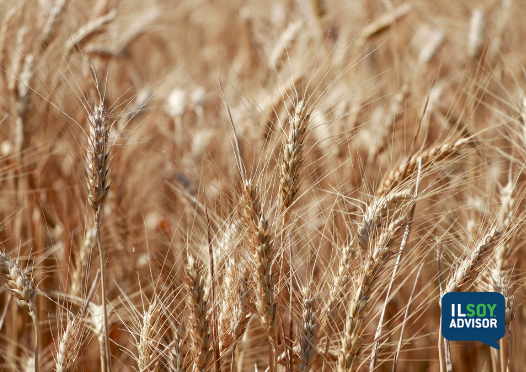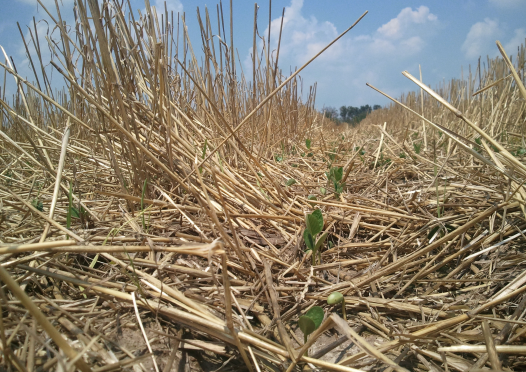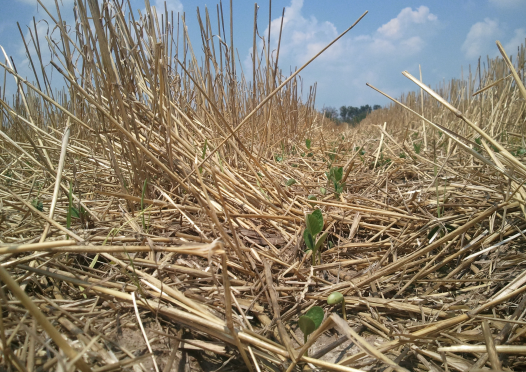BLOOMINGTON, Ill. — The Illinois Wheat Association (IWA) in conjunction with the Illinois Soybean Association is excited to announce the Double Crop Farmers Forum, to be held February 8, 2022, at the DoubleTree by Hilton in Mt. Vernon, Illinois.
Presentations at the conference include best practices for maximizing yields of double-cropped wheat and soybeans, methods to manage diseases, fertilizer price update, USDA programs, market outlooks,... Read More →
ILSOYADVISOR POST
Weather Negates Early Wheat Harvest System Advantage in 2018
August 03, 2018
Adopting the Early Wheat Harvest System can increase the yield of double-crop soybeans, but it doesn’t always work out as planned since weather is the big variable. The key to the wheat/double-crop soybean rotation is to maximize the profitability of both crops, not just one. Briefly, the early wheat system can be described as:
- Plant wheat earlier on the farm in the fall: 3 – 5 days gain on soybean planting
- Plant an early wheat variety: 3 to 5 days gain on soybean planting
- Harvest at 20 – 22% moisture and dry: 3 to 5 days gain on soybean planting
By adopting the early wheat system, growers can create an opportunity to harvest wheat sooner and plant double-crop soybeans 7 to 14 days earlier in most years with normal weather patterns. However, the execution of wheat harvest is also crucial and trying to get every acre harvested at high moisture can be a challenge.
Phil Brown, with Midwest Wheat Consultants, advises growers to plant a range of maturities and time cutting to harvest each at high moisture. “I like two days to harvest the ultra-early, two days to harvest mid-maturity and two days for a full season. And planting a range of maturities helps with issues from frost to disease, drought, etc. Growers can’t harvest more than about 200 acres of wheat in each category in a 2-day period before it dries down. They don’t need 1,000 acres ready to harvest the same day since some of those acres will dry down before being combined.”
While planting earlier maturing wheat varieties is the first step to maximize this double-crop soybean system, varietal maturity is just one consideration in choosing the best fit for a given location and a grower’s overall management system. Additional options including yield potential, disease resistance (especially scab resistance), standability, winterhardiness, etc. should be considered in addition to relative maturity.
With some early varieties already on the market and more in development, varietal options to adopt the early wheat system are expanding. Pairing the right varieties with an earlier, high-moisture harvest will help to maintain grain quality when compared to the risks associated with natural in-field dry down. This system can help maximize profitability of wheat while setting the stage to plant earlier and maximize double-crop soybeans.
The approach to double-crop soybeans is changing as we realize that soybean yields can improve when growers focus on timely (earlier) planting, crop management and harvest, much like for full season soybeans. The key is to plant early, just like full season soybeans, then harvest early. In 2017 and 2018, the Illinois Soybean Association has funded a project to evaluate the performance of the Early Wheat Harvest System at sites in Illinois ranging from south to north. Sites are in Marion, Effingham, Wyoming and Walnut, Illinois.
However, in some years, early wheat varieties may not mature that much sooner than a wheat variety normally selected for the region. And moisture in wheat grain can very quickly dry down in high temperatures, which eliminates the opportunity of harvesting at high moisture and gaining improvements in wheat quality.
Ken McClintock, Limagrain Cereal Seeds Midwestern Manager, indicates, “All wheat varieties can either have day length sensitivity, breaking dormancy as the days have extended sunlight, or can have temperature sensitivity and respond to degree days. This year’s cold spring caused a delay for many varieties to break dormancy, causing a late start and shortening their growing season. It also greatly reduced their development time for the vegetative growth, shortening the height of varieties by 6 to 8 inches.”
This year, weather played a big role with both excesses of rain and temperatures. In Southern Illinois wheat matured earlier than normal. This weather phenomenon narrowed the anticipated maturity spread, with later varieties catching up to early varieties this season. As a result, wheat was ready for harvest 7 to 14 days earlier than normal.
McClintock added, “As the heat turned up in May and day length varieties gathered more sunlight, heat sensitive varieties kicked in and the race was on for all varieties to pollinate. Some of us saw a 3-day difference in pollination time for all varieties and some said it was only 24 hours.”
Typically, wheat maturation follows a natural and predictable timeline. Differences in variety maturity naturally separate out. The early varieties will mature 3 – 7 days before the normal varieties, allowing growers to harvest earlier, then plant double-crop soybeans sooner.
However, the weather in 2018 has been anything but typical. It changed how wheat matured and how harvest progressed.
- April was cooler than normal.
- May was hotter than normal.
- June was warmer and wetter than normal.
A cool April delayed soil warmup, which also delayed wheat green-up. This was followed by a warmer than normal May causing wheat to mature more quickly than expected. Before everyone knew it, the early wheat varieties were maturing quickly, and the normal maturity wheat varieties were right on their heels. Seemingly, they were only a few days apart.
And remember, one of the goals of this system is to harvest wheat at high moisture to preserve test weight and grain quality. As you know, weather still impacts harvest timing. Frequent large rain events in June 2018 accompanied by above average temperatures prevented timely harvest when wheat was at a high moisture level. This was followed by high temperatures, causing early wheat and normal varieties to dry down close to one another toward the harvest moisture of 13 – 14%. Every season is different.
The Early Wheat Harvest System is a good wheat/double-crop-soybean practice. It ensures a better-quality wheat while enabling growers to plant soybeans sooner in most years. We learned this year that wheat will mature more quickly than normal when air temperatures are higher than normal and excess rainfall during June will delay harvest. No matter what system a grower used this year, wheat was harvested earlier and soybeans had a chance to be planted earlier. Nevertheless, the Early Wheat Harvest System is a viable option to consider. It will increase the probability of early harvest even in years when weather conditions allow for later maturing wheat. This system, along with adoption of best management practices, promises to increase the profitability of the double-crop enterprises and enable it to move further north in Illinois.
John Pike at Marion commented “From what I saw this season, if growers had the earlier varieties planted and been harvesting at 18 to 20 percent, most of the problems with the later June rains and double-crop planting delays would have been avoided.” The Early Wheat Harvest System did provide growers more options to manage the weather conditions presented to them.
“It was not a normal year for wheat this season,” concluded McClintock. “But this year’s information and on-going research give us the data to make the best recommendations and set the right expectations. Just as all farmers know, the weather is one major variable which we can’t control but try to manage as best we can with the varieties and planting system we select.”
Soybean agronomist Daniel Davidson, Ph.D., posts blogs on agronomy-related topics. Feel free to contact him at djdavidson@agwrite.com or 402-649-5919.





Comments
Add new comment